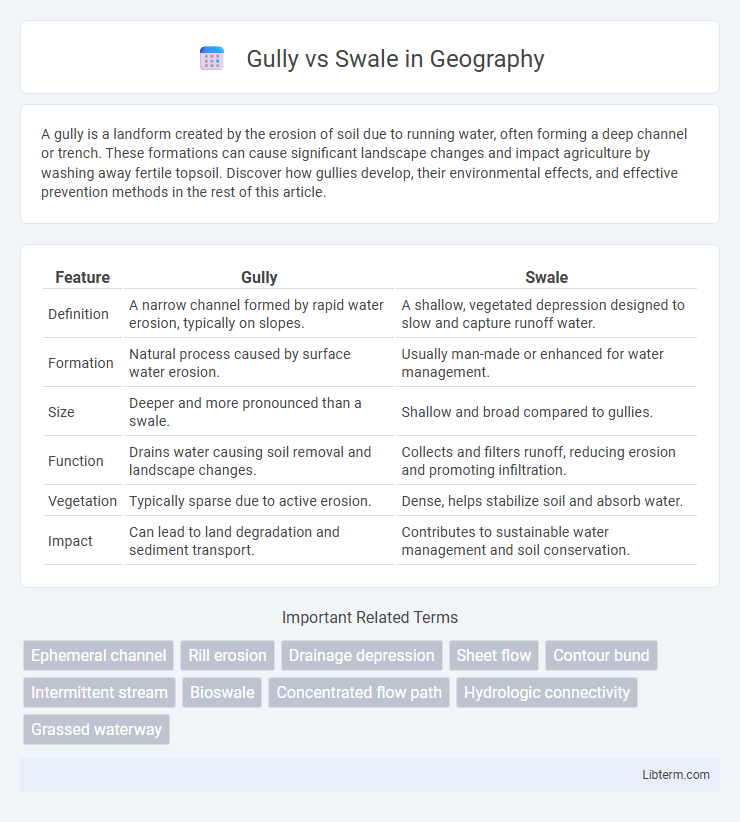A gully is a landform created by the erosion of soil due to running water, often forming a deep channel or trench. These formations can cause significant landscape changes and impact agriculture by washing away fertile topsoil. Discover how gullies develop, their environmental effects, and effective prevention methods in the rest of this article.
Table of Comparison
| Feature | Gully | Swale |
|---|---|---|
| Definition | A narrow channel formed by rapid water erosion, typically on slopes. | A shallow, vegetated depression designed to slow and capture runoff water. |
| Formation | Natural process caused by surface water erosion. | Usually man-made or enhanced for water management. |
| Size | Deeper and more pronounced than a swale. | Shallow and broad compared to gullies. |
| Function | Drains water causing soil removal and landscape changes. | Collects and filters runoff, reducing erosion and promoting infiltration. |
| Vegetation | Typically sparse due to active erosion. | Dense, helps stabilize soil and absorb water. |
| Impact | Can lead to land degradation and sediment transport. | Contributes to sustainable water management and soil conservation. |
Understanding Gully and Swale: Definitions
A gully is a deep channel formed by the erosion of soil, typically caused by concentrated water flow during heavy rainfall, often leading to significant land degradation. A swale is a shallow, vegetated depression designed to manage stormwater runoff by slowing and filtering water, promoting infiltration and reducing erosion. Understanding the distinct functions of gullies and swales is crucial for effective land and water management, especially in erosion control and sustainable drainage systems.
Key Differences Between Gully and Swale
A gully is a deep channel formed by the rapid flow of water, primarily serving to drain excess surface water and prevent soil erosion, whereas a swale is a shallow, vegetated depression designed to slow, capture, and infiltrate stormwater runoff. Gullies often indicate significant soil loss and require immediate intervention, while swales act as sustainable landscape features that promote groundwater recharge and filter pollutants. The key difference lies in their formation and function: gullies result from intense erosion, and swales are intentionally constructed for water management and ecological benefits.
Formation Processes of Gullies
Gullies form through severe erosion caused by concentrated surface water runoff that rapidly removes soil and organic matter, often triggered by heavy rainfall, deforestation, or poor land management. The process involves the development of small channels that deepen and expand as water flow erodes the soil, leading to steep, incised channels with exposed subsoil layers. This rapid incision distinguishes gullies from swales, which are shallow, vegetated depressions formed primarily by gradual surface water collection and sediment deposition rather than aggressive erosional forces.
Natural and Engineered Swales Explained
Natural swales are shallow, vegetated channels designed to slow down stormwater runoff and enhance groundwater infiltration, mimicking natural drainage patterns. Engineered swales are constructed with specific grading, soil composition, and vegetation to improve water quality by filtering pollutants and managing runoff in urban landscapes. Both features help prevent erosion, reduce flooding, and promote sustainable water management in residential and commercial settings.
Causes of Gully Erosion
Gully erosion primarily occurs due to the removal of vegetation cover, intense rainfall, and poor land management practices that expose soil surfaces to concentrated water flow. Steep slopes and compacted or disturbed soils increase the susceptibility to gully formation by accelerating surface runoff. Human activities such as deforestation, overgrazing, and improper agricultural techniques further exacerbate gully erosion by destabilizing soil structure and reducing infiltration.
Environmental Impact: Gully vs Swale
Gullies cause severe soil erosion by rapidly channeling stormwater, which depletes topsoil and increases sedimentation in waterways, negatively affecting aquatic ecosystems. Swales, designed as shallow, vegetated channels, effectively slow runoff, enhance groundwater recharge, and filter pollutants, thereby reducing erosion and improving water quality. Their environmental impact promotes sustainable land management by mitigating flood risks and supporting biodiversity through improved habitat connectivity.
Water Management Roles of Swales
Swales play a crucial role in water management by facilitating the infiltration and slow conveyance of stormwater runoff, reducing surface erosion and flood risks. Unlike gullies, which act as channels for rapid water flow often causing soil erosion, swales are designed to capture, filter, and promote groundwater recharge through vegetation and permeable soils. Their strategic use in urban and agricultural landscapes enhances water quality and supports sustainable drainage systems (SuDS).
Prevention and Control of Gullies
Gullies form due to concentrated water flow eroding soil, while swales are shallow, vegetated channels designed to manage and redirect runoff. Preventing gully formation involves maintaining proper vegetation cover, constructing check dams or gabions to reduce water velocity, and implementing contour farming to minimize soil displacement. Swales control erosion by slowing water flow, enhancing infiltration, and stabilizing soil with deep-rooted plants, effectively preventing further gully expansion.
Best Practices in Swale Design
Effective swale design prioritizes proper sizing and grading to ensure optimal stormwater capture and infiltration, reducing runoff and erosion. Incorporating native vegetation enhances soil stabilization and pollutant filtration, promoting a sustainable and low-maintenance system. Regular maintenance practices, such as sediment removal and vegetation management, sustain swale functionality and prevent clogging.
Choosing Between Gully and Swale for Land Management
Choosing between a gully and a swale for land management depends on the specific water drainage and erosion control needs of the site. Gullies effectively channel large volumes of runoff water to prevent soil erosion in steep or highly erodible areas, while swales provide gentle water conveyance and promote infiltration in flatter landscapes. Prioritizing factors such as slope gradient, soil type, and desired water retention will guide the optimal implementation of either a gully or swale system.
Gully Infographic

 libterm.com
libterm.com